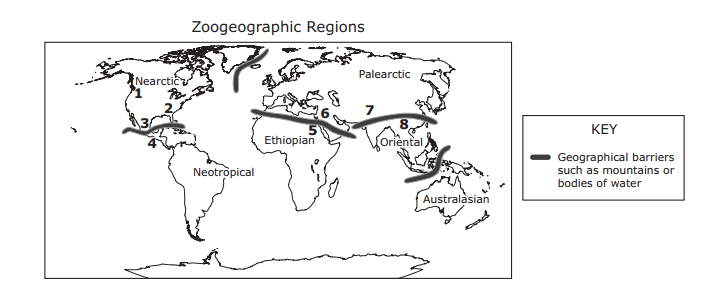
TEKS HS Biology - BIOL.7A Common Ancestry
Quiz by Texas Education Agency
High School
Biology (2017)
Texas Essential Knowledge and Skills (TEKS)
Feel free to use or edit a copy
includes Teacher and Student dashboards
Measures 1 skill from
Measures 1 skill from
Track each student's skills and progress in your Mastery dashboards
With a free account, teachers can
- edit the questions
- save a copy for later
- start a class game
- automatically assign follow-up activities based on students’ scores
- assign as homework
- share a link with colleagues
- print as a bubble sheet
12 questions
Show answers
- Q1Zoogeographic regions are characterized by the presence of specific groups of animals. These regions are determined by the taxonomic or phylogenetic relationships of animals. The map shows the zoogeographic regions proposed by the naturalist Alfred Russel Wallace in 1876. The similarities of organisms in which two areas numbered above provide the best evidence for common ancestry between the organisms in both locations?1 and 25 and 67 and 83 and 460sBIOL.7a
- Q2The limbs of several organisms are shown in the illustrations below. Scientists sometimes compare the limbs of these organisms to look for evidence of common ancestry. These limbs provide evidence of common ancestry because they -have the same basic structureperform the same functionare parts of mammalsare the same size60sBIOL.7a
- Q3The opossum, which is native to North America, and the kangaroo, which is native to Australia, are marsupials. The fact that both these mammals incubate their immature offspring in a pouch provides evidence that they -belong to the same speciesmust range great distances to eatare descended from a common ancestorhave very similar skeletal structures60sBIOL.7a
- Q4Genome maps provide the DNA sequences of chromosomes. Some scientists have compared the genome maps of a hedgehog and a sloth. What do these genome maps allow the scientists to determine?The methods of protein synthesis that each species usesHow closely related the two species are to each otherThe color patterns of the offspring of each speciesHow much the size ranges of the two species differ60sBIOL.7a
- Q5An analysis of DNA and RNA sequences can be used to classify organisms. A dendrogram, such as the one shown below, is based on molecular data. It can be used to represent evolutionary relationships within a group of organisms that are hypothesized to have descended from a common ancestor. Which statement is best supported by the information in this dendrogram?Lesser pandas are more genetically similar to giant pandas than they are to raccoonsThe bear species are all more genetically similar to dogs than they are to giant pandasBrown bears are more genetically similar to giant pandas than they are to sun bearsLesser pandas are more genetically similar to raccoons than they are to giant pandas60sBIOL.7a
- Q6Three species of lizards of the genus Gallotia are found on the Canary Islands, a chain of seven volcanic islands off the west coast of Africa. The easternmost island, Lanzarote, is the oldest, while the westernmost island, El Hierro, is the youngest. The distribution of lizard species is shown on the map below. Which statement about the ancestry of the lizards from the genus Gallotia is best supported by this information?The ancestors of each species evolved in Spain and were brought to the islands at the same timeThe common ancestor of the lizards first colonized the island of El HierroThe common ancestor of the lizards probably came from AfricaThe ancestors of each species came from different continents at different times60sBIOL.7a
- Q7Bactrian camels, dromedaries, llamas, and alpacas are all members of the same taxonomic family, Camelidae. Members of this family all have two toes, no hooves, true canine teeth, and a split upper lip. The family Camelidae originated in North America. The physical features of animals in this family and the family's geographical origin provide evidence that all these animals -have slowly evolved to become herbivoresexchanged DNA at some point in the pasthave a common ancestorlive in the same type of ecosystem60sBIOL.7a
- Q8In 2010, scientists excavated a skull fossil that provides evidence of a newly discovered species of big cat. Based on the evidence, scientists hypothesize that big cats branched off from smaller wild cats about 6 million years ago. Which of these resources did the scientists most likely rely on to form their hypothesis?The historical record of interactions between different species of big catsThe fossil record and DNA comparisons of big cats and small catsA food web showing feeding relationships of organisms where the fossil skull was foundPopulation and migration data for small wild cats living in the ecosystem where the skull was found60sBIOL.7a
- Q9Researchers studying populations of lizards from the genus Gallotia on the Canary Islands compared the protein cytochrome b in different populations. The table shows the number of differences in the cytochrome b protein between different populations. Which conclusion about the relatedness of the lizards do these data support?G. galloti eisentrauti and G. galloti palmae are the most closely relatedG. simonyi and G. bravoana are the most closely relatedG. galloti eisentrauti and G. galloti galloti are the least closely relatedG. atlantica and G. stehlini are the least closely related60sBIOL.7a
- Q10Cetaceans are whales and their relatives. The diagram shows some fossils of cetaceans. Which statement provides the best evidence that Ambulocetus natans is an ancestor of Basilosaurus isis?Similar nitrogenous bases are found in the DNA of each fossilHomologous structures occur in each fossilThe youngest fossil is larger than the older fossilsThe fossils were found in different locations60sBIOL.7a
- Q11Scientists can determine relatedness among organisms by comparing partial amino acid sequences. The table shows four partial amino acid sequences from four organisms. Which organism is the LEAST related to the other three organisms?Organism 4Organism 3Organism 1Organism 260sBIOL.7a
- Q12The image shows part of the humerus bone in different genera of primates. Which statement is best supported by the observable structures of the different humerus bones?The primates shared a common ancestor.The primates interbreed with similar organisms in a population.The primates had diets that consisted of similar types of foods.The primates lived in similar environments.60sBIOL.7a
